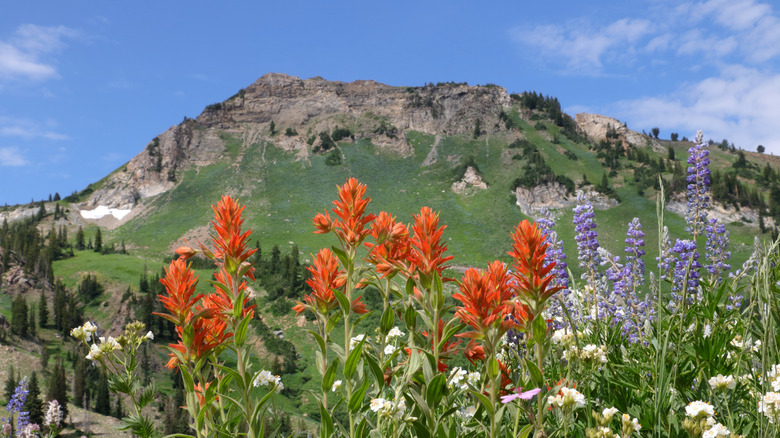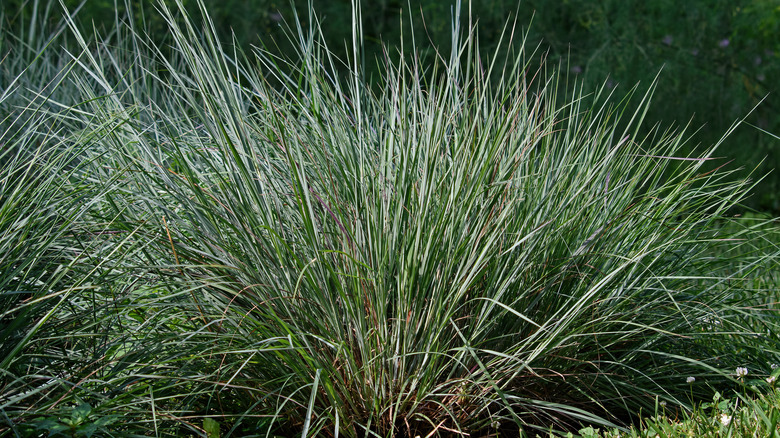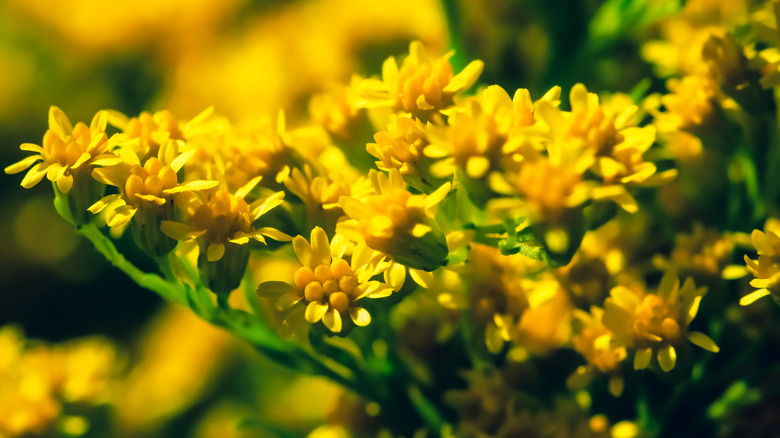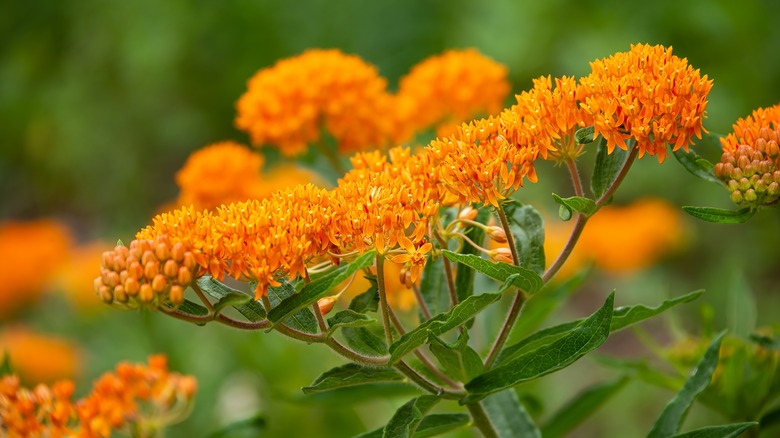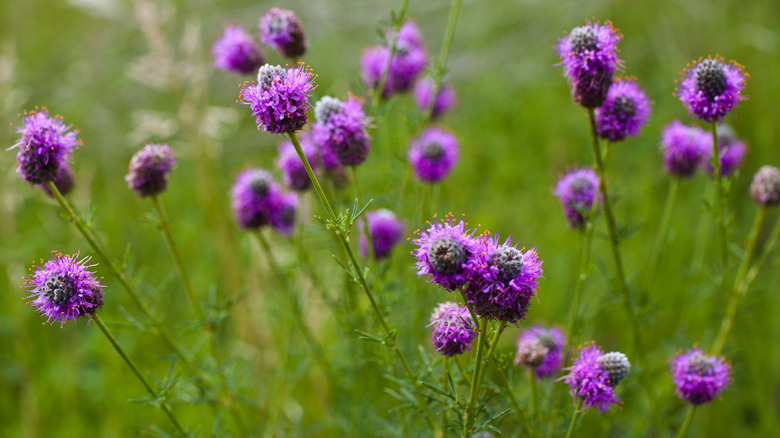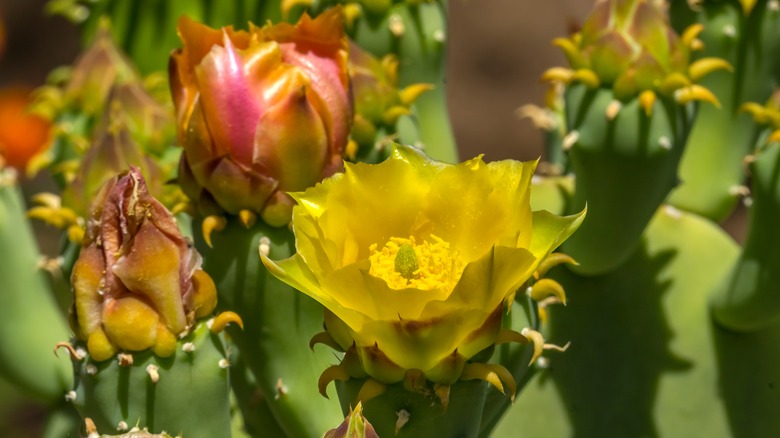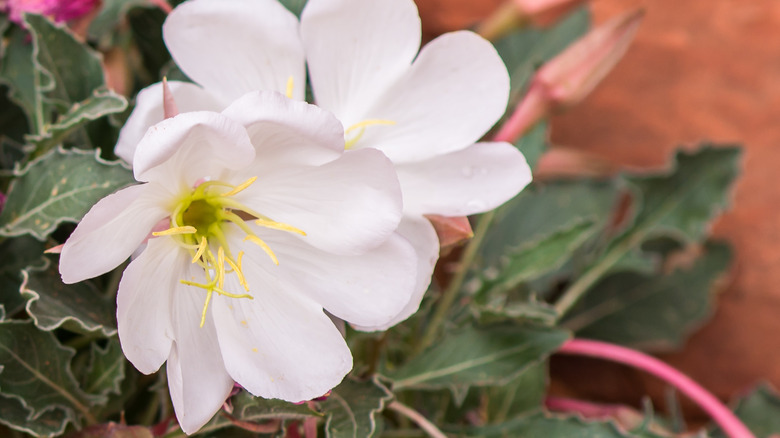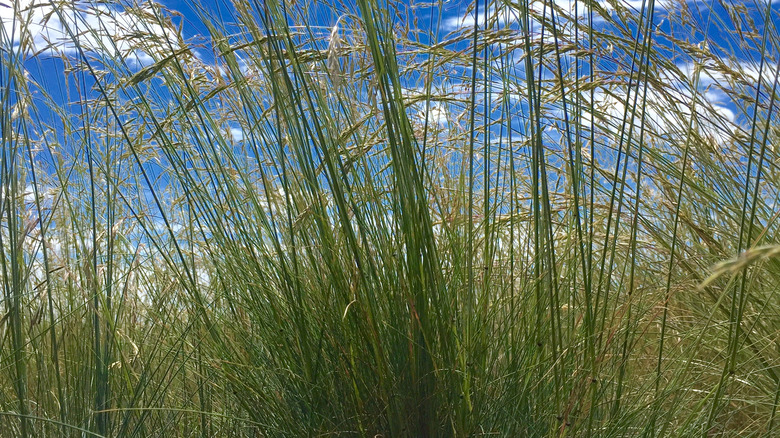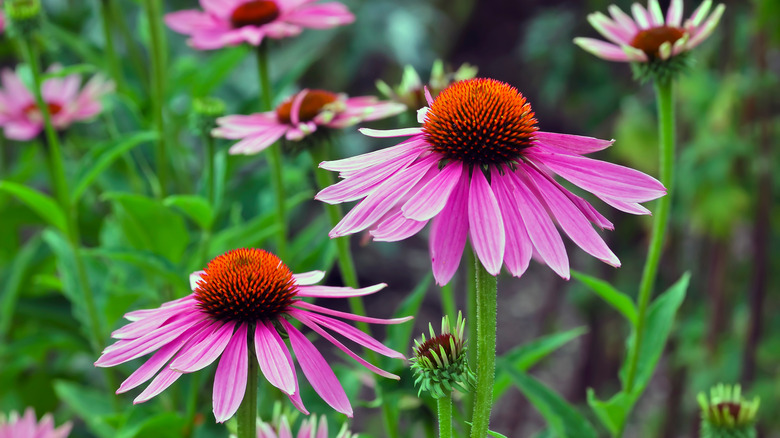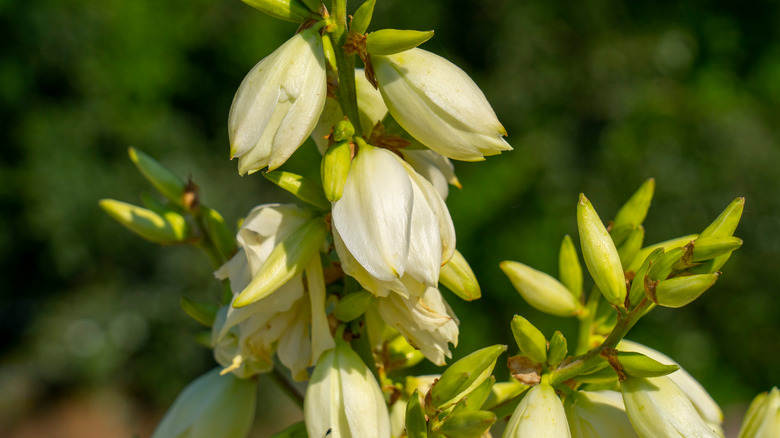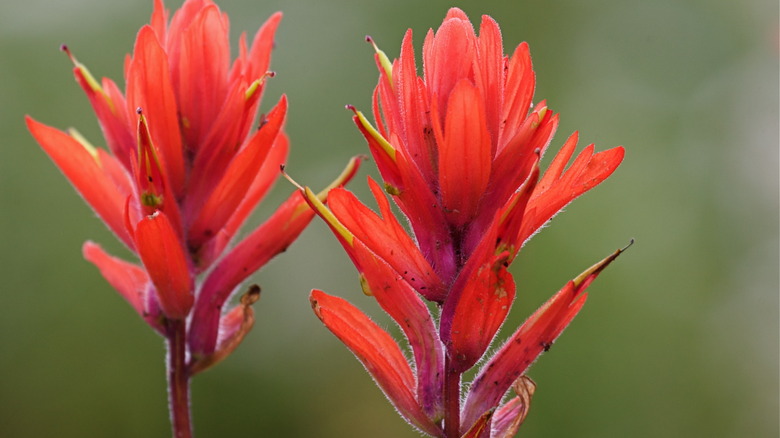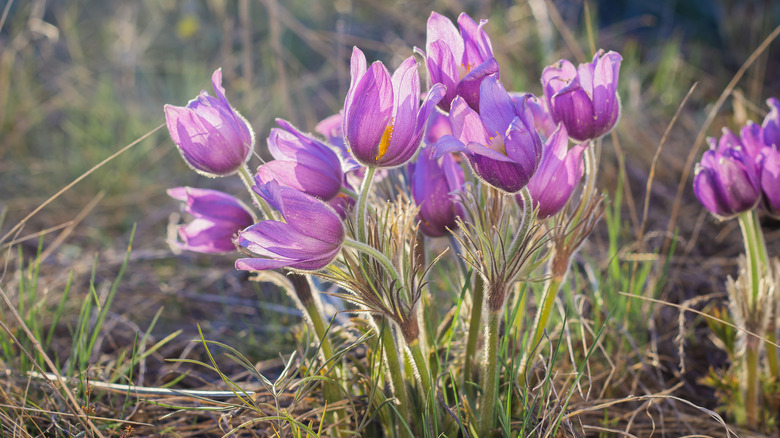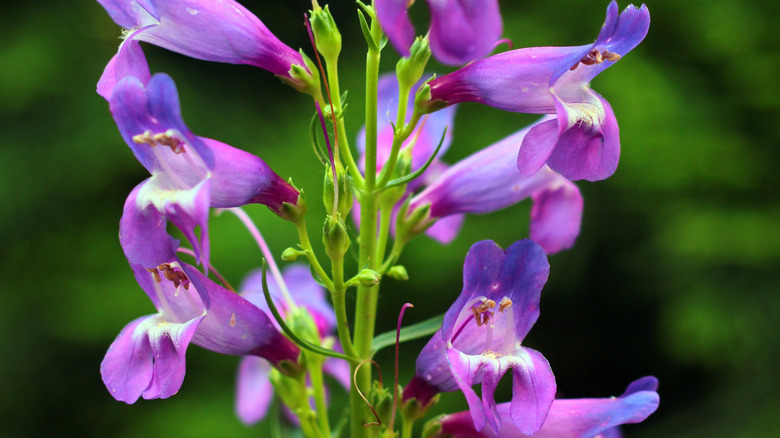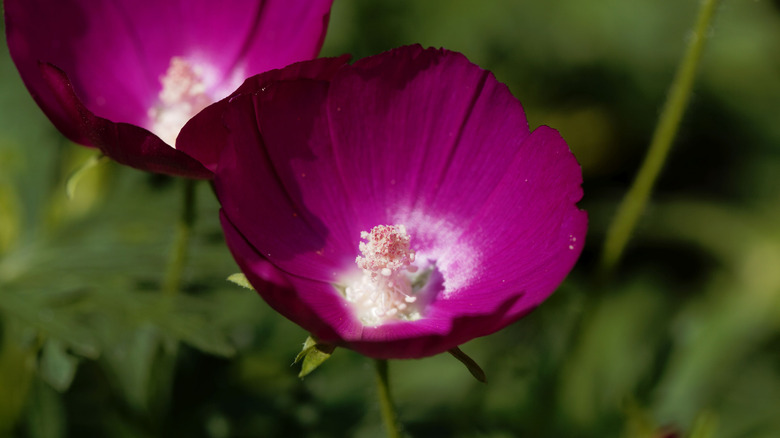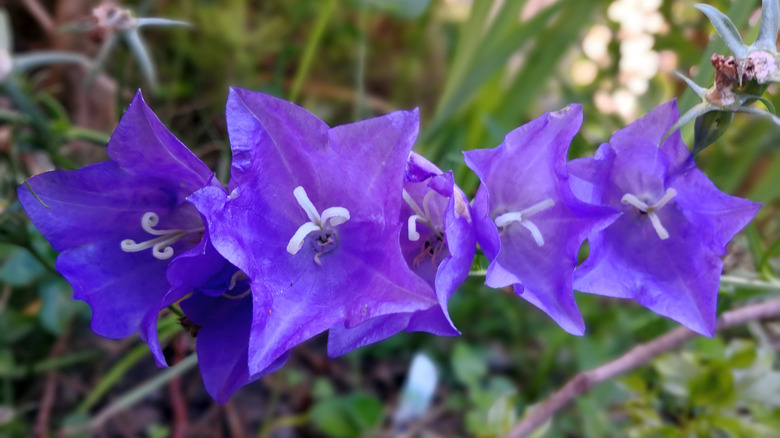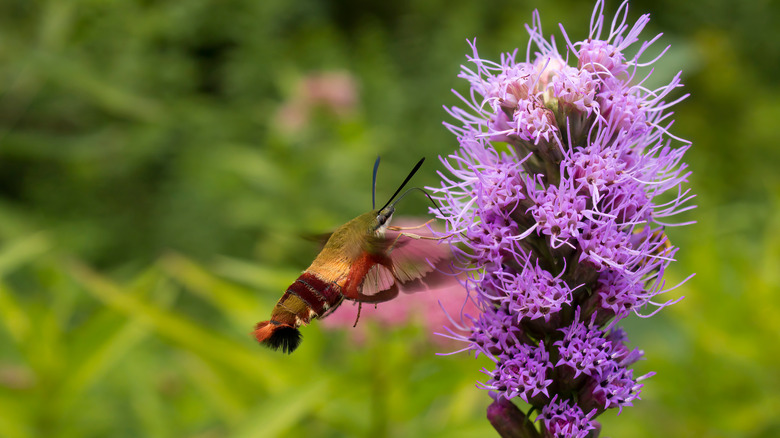15 Best Native Plants To Grow If You Live In The Mountain West Region
The Mountain West region of the United States is one of four major regions. It includes the states of Arizona, Idaho, Colorado, Montana, New Mexico, Utah, Nevada, and Wyoming. Though some of these states also belong to smaller subregions, such as the Inland Northwest, the Southwest, and the Far West, this larger group works well as a general area to find plants native to the mountainous areas that follow the path of the Rocky Mountains. This path, as described by the National Park Service, includes four major mountain systems, which give it the most diverse climate and terrain compared to other U.S. regions.
Plants native to these areas typically share similar traits such as drought tolerance, cold tolerance, and the ability to attract local wildlife and native species of beneficial insects. Flowers such as Rocky Mountain penstemon, bluebell bellflower, and winecups give butterflies the nectar that they need, while grasses like little bluestem and beargrass host essential moth and butterfly larvae. Growing native plants in your garden is important for the survival of local species, and they pay it forward by thriving in your yard even with very little care.
1. Little bluestem
Little bluestem (Schizachyrium scoparium) is a native larval host plant that provides Mountain West wildlife and insects with food, shelter, and a place to give way to a new generation, according to North Carolina State Extension. An ornamental grass, the little bluestem plant grows in a range of conditions across the region, and it is recommended for planting in native gardens, border gardens, and pollinator gardens.
Bloom Season: Summer to fall
USDA Growing Zone: 3 to 9
Growing Conditions: Full sun
Soil Type: Well-draining
Size: 2 to 4 feet tall and 1 to 3 feet wide
2. Goldenrod
Goldenrod (Solidago rugosa) is a plant with a complicated reputation. It is described as weedy, unattractive, and invasive, and it is thought to cause hay fever, as told by the University of Wisconsin-Madison. In truth, it does not cause hay fever, and many goldenrod varieties have few disease problems, pests, or unruly foliage and flowers. Adding goldenrod to your native garden can supply you with many more benefits than detriments.
Bloom Season: Summer and fall
USDA Growing Zone: 4 to 8
Growing Conditions: Full sun to partial shade
Soil Type: Well-drained
Size: 3 to 4 feet tall
3. Butterfly weed
Butterfly weed (Asclepias tuberosa), as you might expect, is named after its ability to grow quickly and aggressively. The plant grows in lots with well-drained soil in open woods, hillsides, and canyons, as mentioned by the Lady Bird Johnson Wildflower Center. Butterfly weed has a high ornamental value from its orange and yellow flowers, but it really shines when it attracts butterflies and hummingbirds.
Bloom Season: Spring to fall
USDA Growing Zone: 3 to 9
Growing Conditions: Full sun
Soil Type: Well-drained
Size: 1 to 2 feet tall
4. Purple prairie clover
The purple prairie clover (Dalea purpurea) is a commonly found wildflower in North American gardens. Though its appearance may be boring to some, it is a wonderful plant that is rarely killed by heat, drought, or foot traffic. The flower is also extremely beneficial to native gardens as it attracts pollinators, and when it does eventually die, it enriches the soil with its spent blossoms and leaves, as per Prairie Nursery.
Bloom Season: Summer
USDA Growing Zone: 3 to 8
Growing Conditions: Full sun
Soil Type: Well-drained
Size: 1 to 2 feet tall
5. Plains prickly pear
The plains prickly pear (Opuntia polyacantha), which is also referred to as the hair-spine prickly pear and nopal peludito, is a member of the cactus family that can withstand the Mountain West region's sometimes chilly climate. The plant is identified as a low-growing cactus made up of blue-green pads and brightly-colored flowers that appear in the spring, as noted by the Lady Bird Johnson Wildflower Center.
Bloom Season: Spring
USDA Growing Zone: 3 to 7
Growing Conditions: Full sun
Soil Type: Well-drained and sandy
Size: 16 inches tall and 10 feet wide
6. Tufted evening primrose
Tufted evening primrose (Oenothera caespitosa) is a species of herbaceous perennials that only grow up to 10 inches high. Native Plants for the Intermountain West describe them as almost maintenance-free because, when planted in their native environment, they can get all the resources they need from the land and the sky. Typically, they do not need to be deadheaded, fertilized, or even watered.
Bloom Season: Spring to summer
USDA Growing Zone: 4 to 8
Growing Conditions: Full sun to light shade
Soil Type: Well-drained
Size: 6 to 10 inches tall and 2 feet wide
7. Idaho fescue
Idaho fescue (Festuca idahoensis) is an ornamental grass that blooms with tall, white flower stalks in the spring. It also features evergreen blue-green foliage that adds interest to native gardens in the winter. As said by High Country Gardens, the plant will need little maintenance once it is established.
Bloom Season: Late spring
USDA Growing Zone: 5 to 9
Growing Conditions: Full sun
Soil Type: Well-drained with low fertility
Size: 15 to 16 inches tall and 15 inches wide
8. Black samson
Black samson (Echinacea angustifolia), also known as the narrow-leaf coneflower, is a versatile plant that grows in a range of conditions throughout Central North America. This particular coneflower species is tolerant of heat, drought, and poor soil, says Missouri Botanical Garden. In the Mountain West region, this flower commonly grows in open woods, meadows, and prairies where it can be reached by direct sunlight.
Bloom Season: Summer
USDA Growing Zone: 3 to 8
Growing Conditions: Full sun
Soil Type: Well-drained
Size: 1 to 2 feet tall and 9 to 18 inches wide
9. Plains yucca
Plains yucca (Yucca glauca), also known as beargrass, small soapweed, and narrow-leaf yucca, is a member of the agave family. Most often, it is purchased by gardeners for its beautiful foliage and bell-shaped flowers that are green and white, explains North Carolina State Extension. In areas of the Mountain West region with dry and rocky soil, it may be found growing naturally in grasslands and desert prairies.
Bloom Season: Summer
USDA Growing Zone: 4 to 8
Growing Conditions: Full sun
Soil Type: Well-drained
Size: 3 to 5 feet tall
10. Wyoming Indian-paintbrush
Wyoming Indian-paintbrush plants (Castilleja linariifolia) are regarded for their bright red and orange flower stalks that are frequently compared to torches. The flowers bloom for a long time from May to October, and they can grow atop 30-inch-tall stems when planted in their native environment, as indicated by the Lady Bird Johnson Wildflower Center.
Bloom Season: Spring to fall
USDA Growing Zone: 3 to 8
Growing Conditions: Partial shade
Soil Type: Well-drained and moist
Size: 30 inches tall
11. Pasqueflower
Pasqueflowers (Pulsatilla patens) have a reputation for being one of the first flowers to bloom in some parts of the United States, including in the Mountain West region, the Great Plains region, and the northern tundra, as stated by Missouri Botanical Garden. They grow well in cooler climates where they have access to direct sunlight and extremely well-draining soil.
Bloom Season: Spring
USDA Growing Zone: 3 to 7
Growing Conditions: Full sun
Soil Type: Well-drained and gritty
Size: 3 to 12 inches tall and 3 to 6 inches wide
12. Rocky Mountain penstemon
Rocky Mountain penstemon (Penstemon strictus) is known for its spikes of colorful flowers that can appear in blue or purple. They are highly ornamental and resemble dragon flowers in the Antirrhinum genus. However, Rocky Mountain penstemon is much more cold hardy and slightly taller. As High Country Gardens notes, this plant attracts bees, hummingbirds, and butterflies, so don't hesitate to add it to your native garden.
Bloom Season: Spring
USDA Growing Zone: 4 to 9
Growing Conditions: Full sun
Soil Type: Well-drained and sandy
Size: 24 to 30 inches tall and 36 inches wide
13. Winecups
Winecups (Callirhoe involucrata) can be used in an informal border garden, a native garden, or as ground cover, as suggested by the University of Wisconsin-Madison. This gorgeous, mat-forming flower is a long-bloomer that displays red wine-colored blossoms among its many trailing stems. It pairs well with other drought-tolerant perennials in this collection such as plains prickly pears, narrow-leaf coneflowers, and tufted evening primroses.
Bloom Season: Summer
USDA Growing Zone: 4 to 8
Growing Conditions: Full sun
Soil Type: Well-drained sand or loam
Size: 4 to 6 inches tall
14. Bluebell bellflower
The bluebell bellflower (Campanula rotundifolia), which is also called the hareflower and witches' thimble, is known for its delicate flowers that give off a fairytale-like aesthetic. These flowers are bell-shaped with five points and fade from white at the center to blue-purple at their tips, as shown by Prairie Nursery. In the northern hemisphere, you'll find these ethereal flowers growing in dry prairies and grasslands.
Bloom Season: Summer and fall
USDA Growing Zone: 2 to 7
Growing Conditions: Full sun
Soil Type: Well-drained sand or gravel
Size: 1 to 2 feet tall
15. Prairie blazing star
Prairie blazing star (Liatris pycnostachya) may be a member of the daisy family, but it's difficult to discern that from its features. This plant has tall flower stalks that bloom with purple flowers and linear leaves that splay outward like the branches of a Christmas tree. North Carolina State Extension describes this flowering plant as an ornamental perennial and suggests using it in several types of gardens, including native or naturalized gardens.
Bloom Season: Summer and fall
USDA Growing Zone: 3 to 9
Growing Conditions: Full sun
Soil Type: Well-drained
Size: 2 to 4 feet tall
